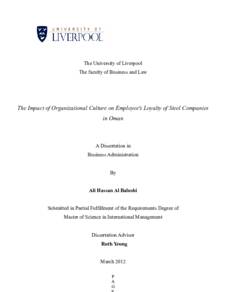Document
The Impact of Organizational Culture on Employee's Loyalty of Steel Companies in Oman
Language
English
Subject
English abstract
Organizational culture is considered as a key element that provides an organization with unique characteristics and attributes that distinguishes it from other organizations. The aim of this study is to identify the dimensions of organizational culture and level of employees' loyalty in steel companies, and to investigate the impact of organizational culture on employees' loyalty in the context of steel companies in Oman since companies in the steel industry is one of most important industrial companies in Oman. This study used mixed methods design in the form of quantitative and qualitative methods, such as interviews and survey with different statistical methods such as one-sample t-test ANOVA and correlation analysis to obtain the results as well as successfully answered the research questions.16 participants using purposeful sampling method for the qualitative study and 150 respondents for the quantitative study using quota sampling method covered four steel companies in the Sohar industrial area in Sultanate of Oman. The results reveal that the dimensions of organizational culture include values, innovation, aggressiveness, attention to detail, physical factors, leadership and the pattern of communication practice, as well as attention to customers. The level of employees' loyalty is high, and there is a positive relationship between organizational culture and employee's loyalty in steel companies in Oman. It is recommended that steel companies should continue to maintain the dimensions of organizational culture, adopt the principle of efficiency, set high standards for the performance of working groups in the company and develop them through comparing between the present situation in the company and the goal that seeks to reach, as well as focus on using modern technology as the basis for the application of the training programs to improve employees' performance. Generalization of the results is restricted due to very small sample size when comparing with the total number of employees in steel companies in Oman and the interpretation of the qualitative data. Moreover, some participants have kept on answering while some others gave very brief answers. In other words, some participants exaggerated in answering the questions while others were not willing to express their opinions.
Member of
Resource URL
Category
Theses and Dissertations

